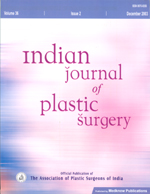
|
Indian Journal of Plastic Surgery
Medknow Publications on behalf of Indian Journal of Plastic Surgery
ISSN: 0970-0358 EISSN: 1998-376x
Vol. 40, Num. 2, 2007, pp. 181-181
|
Indian Journal of Plastic Surgery, Vol. 40, No. 2, July-December, 2007, pp. 181
Invited Discussion
Facial aging: A clinical classification
R. K. Khazanchi
Department of Plastic and Cosmetic Surgery, Sir Ganga Ram Hospital, New Delhi - 110060
Correspondence Address:Department of Plastic and Cosmetic Surgery, Sir Ganga Ram Hospital, New Delhi - 110060
Code Number: pl07051
Better understanding of anatomy of aging face has led to the evolution of facial rejuvenation from a simple face lift operation in the past to a combination of a variety of procedures such as limited face lift, thread lift, fillers, botulinum toxin, lasers, intense pulsed light, chemical peels etc. Since different people age differently, there is no simple cut and paste solution for every one.
In this paper, the author has made an attempt to present a simple clinical
classification of facial aging. The need for this classification is to
guide the facial plastic surgeon to choose the right combination of various
facial rejuvenation procedures that are available today in order to achieve
the best possible result. The author has described four stages of facial
aging taking into account the presence and extent of tear trough, nasolabial
folds and jowls.
Although these are the more commonly seen effects of facial aging,
there are many other parameters and regions of the face which need assessment
and are used as treatment guides. The changes in facial skin for example
can be graded into wrinkles, furrows and folds. Whereas wrinkles and furrows
can be treated by lasers or dermabrasion, folds need treatment by a surgical
or a thread lift. The dynamic creases need to be differentiated from static
creases to identify the need for either botulinum toxin or fillers. The
pigment changes in the skin also need to be defined which may require a
treatment with creams or photo rejuvenation. The degree of loss of subcutaneous
fat needs to be assessed by using the patient's previous photographs to determine the need for fat injections. Fat deposits in the eyelids, cheeks and neck need identification and appropriate surgical correction. All regions of face including forehead, eyelids and neck need detailed clinical assessment to tailor treatment to individual patients need.
This paper is a good beginning towards developing a classification
of facial aging. However it focuses only on some common sequelae and
does not address
the entire gamut of changes in aging face. I am sure that using this
as a baseline, many detailed classifications will evolve in our quest
to achieve
perfection in facial rejuvenation surgery.
Copyright 2007 - Indian Journal of Plastic Surgery
|
